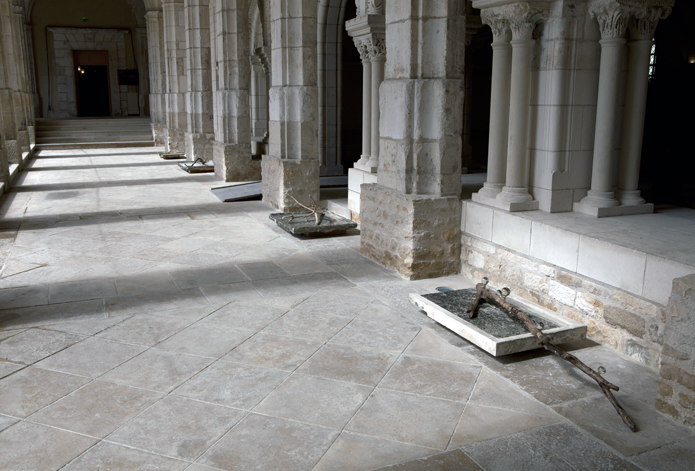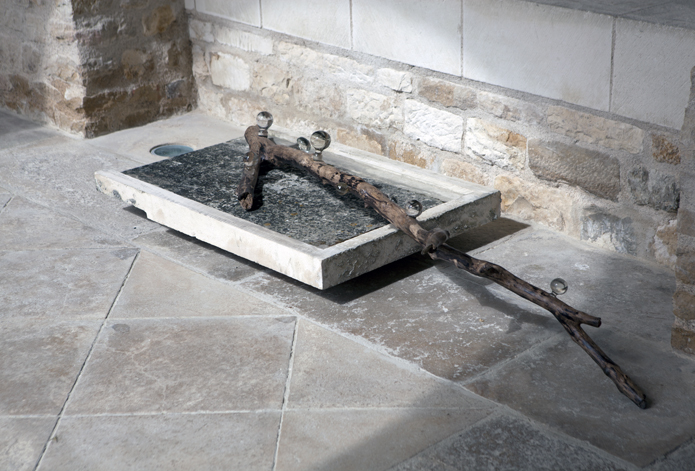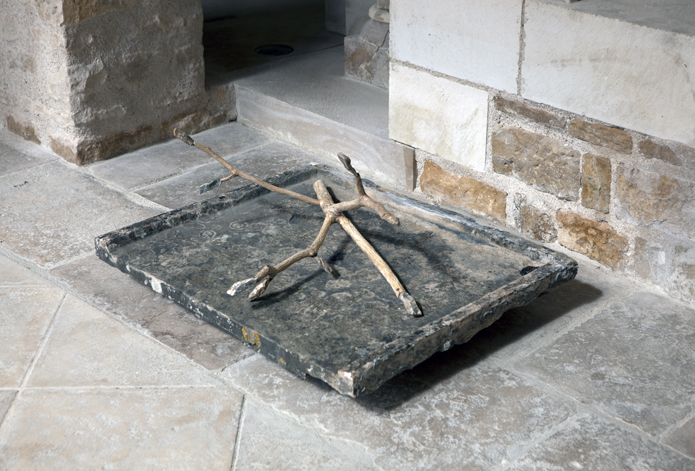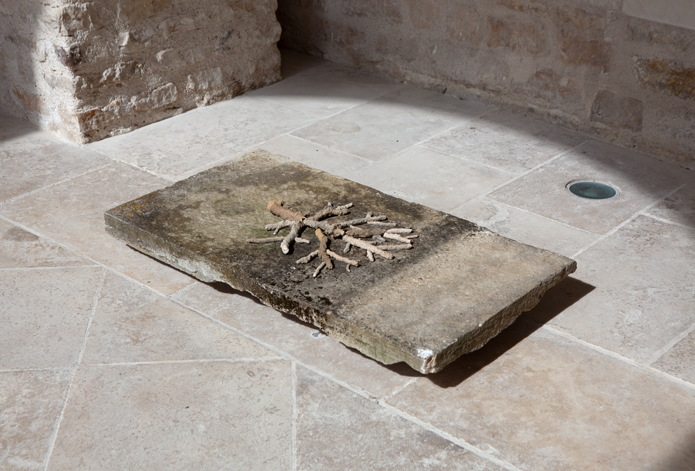

Ash wood, crystal, variable dimensions.


Ash wood, flint bifaces from Vexin, variable dimensions.


Spruce wood, bivalve fossils (Lopha Gregarea), variable dimensions.


Fulgurite, variable dimensions.

From June 15 to November 3, 2024
Exhibition in partnership with the Centre Pompidou
Hugues Reip, Magical landscapes
“I believe that my appetite for micro‑universes comes from a taste for contemplating the infinitely small in nature as well as literature. To look at a world in motion without moving. It is therefore a question of appealing to the imagination at the very heart of reality.” HR
Hugues Reip, a collector of minerals and herbaria, is a shaper of worlds and fantas‑ tical creatures. Drawing from the realms of natural sciences and the marvelous be‑ queathed by the 19th century, his works its creative power to imagination and invite us to reinvent our perspective on the things that surround us, however minute they may be. In the artist’s compositions, crystals, fos‑ sils, and plants combine in various layers to give life to a fauna and flora with a strange and poetic anatomy. For the four paintings conceived for this exhibition, Hugues Reip plays with disruptions of scale and unex‑ pected formal encounters to produce sig‑ nificant effects of derealization. Dedicated to the four elements—water, fire, earth, and air—each of his fictional landscapes, which the artist regards as paintings, are the site of invention for a fabricated botany in which the vegetal melds with the mineral, the animate with the inanimate, the ratio‑ nal with the irrational. In the manner of a gardener passionate about alchemy and magical thinking, he creates from scratch a reenchanted natural world. Sheltered beneath the arches of the Abbey cloister gallery, these pieces of hallucinatory garden, where the improbable grows, act as pas‑ sages, thresholds between different worlds and sensitive states. In the direct line of the surrealist tradition initiated by Max Ernst and Joseph Cornell, Hugues Reip gives his hybrid landscapes the appearance of mate‑ rialized dreams.
Entretien Hugues Reip
with Jonathan Pouthier & Inés Vázquez Messano
“When you walk through the woods keeping your eyes fixed on the ground, you will doubtless discover many wonderful, miraculous things. But when you suddenly look upwards into the sky, you are overcome by the revelation of another, equally miraculous world”wrote Max Ernst. The four landscapes you have designed for this exhibition seem to redo this exercise enunciated by the Surrealist artist. Is it possible to see them as a kind of interface between the visible part of the world and its magical part ?
Hugues Reip
I’m a great admirer of Max Ernst and in particular of his petrified forests, where mineral and plant form a single kingdom. I wasn’t familiar with this quote, but it’s very beautiful and it captures the way he saw the universe. From the infinitely small to the terribly large. He even spoke of being ‘overwhelmed’ by the revelation of another world. In 2008, I organised an exhibition at the Museum of contemporary art of Tokyo entitled Parallel World in which, alongside my own work, I invited Japanese and French artists to discuss this theme. The Japanese call this permeability between the real and imaginary worlds Yokai. It’s a concept I really like. I’m a bit like Alice, I sail around wandering.
JP & IVM
What can we see with the naked eye ?
HR
It would seem that the smallest object visible to the naked eye is bacteria. But in the surreal sense of the term, your question would almost define the vision of an eye stripped of all preconceptions, allowing it to see the invisible.
JP & IVM
What is your relationship with your worlds? Should we look at them as if they were paintings or sculptures, or let our imaginations wander as we would in the middle of a forest or a garden ?
HR
I mentioned Alice earlier, but I’m also a big fan of Jonathan Swift’s Gulliver. Both these characters have the strange ability to grow or shrink and to see the world in that light. I believe that my appetite for micro‑universes comes from a taste for contemplating the infinitely small in nature as well as literature. To look at a world in motion without moving. It is therefore a question of appealing to the imagination at the very heart of reality.
JP & IVM
Your creations seem to come straight out of a fantastic imagination from which hybrid organisms and creatures emerge. Like a place of all possibilities, your landscapes give rise to a flora and fauna where fake flowers, fossils, flints and trees merge to create a magical, poetic world. Can we see this nature as a way of moving from reality to dreams ?
HR
When Lucian of Samosate wrote the very first known science‑fiction text in the 2nd century, recounting the author’s journeys beyond the worlds he had envisaged, he drew on mythology, the absurd, fabrication and impertinence, and paradoxically entitled his work A True Story. My works often contain a dreamlike element and create a space of fantasised reality.
JP & IVM
The change of scale is a recurring theme in your work. What drives you to make this leap? Do you find the infinitely large in the infinitely small ?
HR
It’s likely that a comet, or a comet shower, was the origin of life on earth. The telescoping of two pebbles, as it were. Could the idea of banging two flints together to produce a spark be a reminder of this enormous original percussion? I don’t think so, but these two founding events for humanity are bringing about the same revolution on two radically different scales.
JP & IVM
Why have you dedicated each painting to an element: water, fire, air and earth ?
HR
I think that I need a guiding idea to get me started, for a form of coherence to rule the diversity of my proposals. Here, mineral leaves grow on the branches of the trees, evoking the four elements in a very metaphorical way; bifaces for earth, marine fossils for water, crystal spheres for air and fulgurites for fire.
JP & IVM
You have chosen to place your micro‑worlds at the cardinal points of the Abbey’s cloister, a place designed as an interface between heaven and earth, between the visible and the invisible. Visitors are invited to wander around and mentally reconstruct this fantastic landscape. Do you think that a fragment can be seen as a whole ?
HR
Visiting exhibition venues is always a determining factor for me. The famous Genius Loci, a protective spirit of places in Roman belief. If the pieces are not pre‑existing and I’m lucky enough to be able to work in situ, I always start from this observation. Here, the passageways gave rise to the idea of installing four sculptures on the four sides of the cloister and working on the four elements. And then, I was born on April 4th [laughs]. Of course, I liked the idea of wandering around and not seeing all four installations at the same time. So it’s still a matter of immobile travel.
JP & IVM
You have decided to work with the ashlars from the cloister roof. They are like the mineral backdrops to your paintings. This gesture of reuse, but also of reversal, could be like turning over a stone on the ground: a moment of discovery of a hidden world. Are your stones spaces of revelation ?
HR
The large limestones that cover the corridor of the cloister are being replaced, and I was able to use four of them as a horizontal backdrop against which the trees described above would rest. As I talk about them, I realise that they are also like recumbent effigies...
JP & IVM
Your work incorporates both living and non‑living elements. Your assemblages fix the natural and at the same time breathe life into it, by creating unusual relationships between their components. These interactions invite us to imagine possible worlds, reinventing the concept of still life as a fantastic animated universe. Could you explain how you conceptualise these assemblages ?
HR
The recent sculptures, these hybridisations, these still lives, were born during the first lockdown. I was lucky enough to be in the countryside but had little or no materials at my disposal to work with. I naturally went back to the way I’d grown up in the mountains, looking for stones, carving pieces of wood, making collages and assemblages. What used to be a remedy for boredom had become a reminder of wonderful carefree moments.